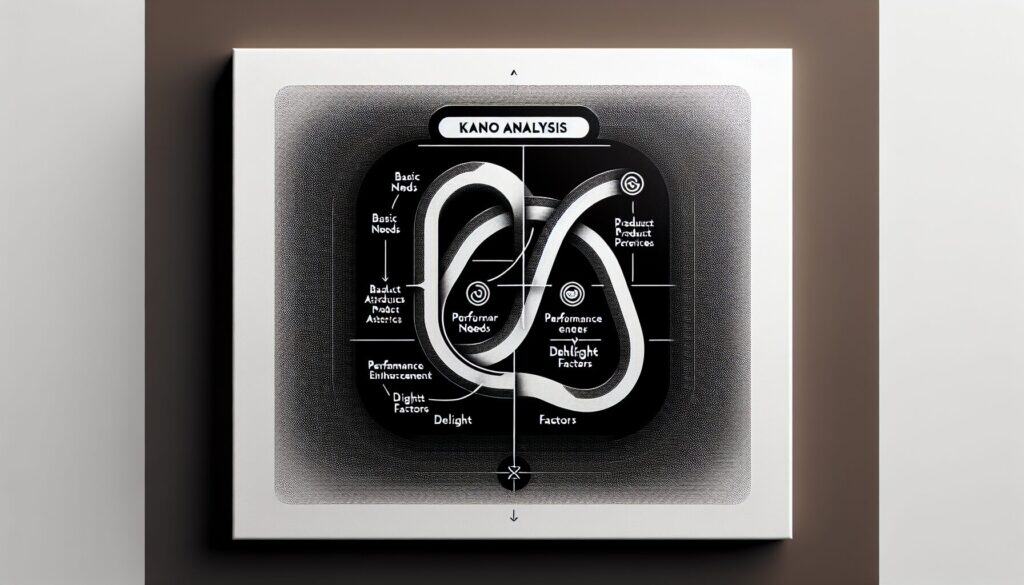Identificare e classificare le preferenze dei clienti per le caratteristiche dei prodotti, distinguendo tra quelle che soddisfano le esigenze di base, migliorano le prestazioni o soddisfano i clienti.
- Metodologie: Clienti e marketing, Ideazione, Progettazione del prodotto
Analisi di Kano (Modello di Kano)

Analisi di Kano (Modello di Kano)
- Esperienza del cliente, Mappatura del viaggio del cliente, Pensiero progettuale, Innovazione, Sviluppo del prodotto, Gestione del prodotto, Distribuzione delle funzioni di qualità (QFD), Esperienza utente (UX), Proposta di valore
Obiettivo:
Come si usa:
- I clienti vengono intervistati utilizzando una coppia specifica di domande (forme funzionali e disfunzionali) per ogni caratteristica. Le risposte vengono poi mappate in categorie: Qualità obbligate, Prestazioni, Attraenti (Deliziati), Indifferenti e Inverse.
Professionisti
- Aiuta a dare priorità allo sviluppo delle funzionalità in base all'impatto sul cliente, identifica le esigenze inespresse dei clienti (delatori), evita di investire eccessivamente in funzionalità a basso impatto, fornisce un quadro di riferimento per la comprensione delle dinamiche di soddisfazione dei clienti.
Contro
- Richiede un'attenta progettazione e somministrazione del sondaggio, l'analisi dei dati può essere complessa, le preferenze dei clienti possono cambiare nel tempo, l'interpretazione dei risultati necessita di un contesto e può essere soggettiva.
Categorie:
- Clienti e marketing, Ideazione, Progettazione del prodotto, Qualità
Ideale per:
- Dare priorità alle caratteristiche del prodotto, comprendere le aspettative dei clienti e identificare le opportunità di innovazione concentrandosi sugli attributi che portano alla soddisfazione e al piacere dei clienti.
La Kano Analysis è particolarmente vantaggiosa nelle prime fasi di sviluppo del prodotto, dove la comprensione delle preferenze dei clienti può influenzare in modo significativo le decisioni di progettazione e l'allocazione delle risorse. Settori come la tecnologia, l'automotive, l'elettronica di consumo e la sanità applicano spesso questa metodologia per valutare l'allineamento delle diverse caratteristiche con le aspettative degli utenti. La partecipazione coinvolge tipicamente team interfunzionali, tra cui progettisti, ingegneri, specialisti di marketing e rappresentanti del servizio clienti, che collaborano per raccogliere e interpretare il feedback dei clienti. Le intuizioni derivate dal Modello di Kano consentono ai team di identificare quali caratteristiche sono standard essenziali, come la durata della batteria nei prodotti elettronici, che devono essere soddisfatte per evitare l'insoddisfazione, e quali caratteristiche possono deliziare gli utenti, come interfacce utente innovative o finiture estetiche uniche che superano le aspettative di base. Questo approccio proattivo può portare a innovazioni strategiche che potrebbero non essere state considerate inizialmente, in quanto rivela i desideri latenti dei clienti che possono distinguere un prodotto dalla concorrenza. Inoltre, le organizzazioni possono evitare un'errata allocazione delle risorse riconoscendo le caratteristiche classificate come qualità indifferenti o inverse, assicurando così che gli investimenti nello sviluppo del prodotto si concentrino sugli attributi che migliorano realmente la soddisfazione dell'utente. Nel corso della ricerca, metodologie come i sondaggi possono essere utilizzate efficacemente per segmentare le risposte dei clienti, fornendo approfondimenti granulari che pongono le basi per il perfezionamento iterativo del prodotto.
Fasi chiave di questa metodologia
- Sviluppare un elenco di caratteristiche o attributi del prodotto da valutare.
- Formulare coppie di domande per ogni caratteristica, sia in formato funzionale che disfunzionale.
- Somministrare il sondaggio ai clienti e raccogliere le loro risposte.
- Analizzare le risposte dei clienti mappandole nelle categorie di Kano: Must-be, Performance, Attraente, Indifferente e Negativo.
- Dare priorità alle funzionalità in base alla loro categorizzazione e all'impatto sui clienti.
- Individuare le opportunità di innovazione e di miglioramento attraverso l'analisi delle persone più attente.
- Rivedere e adattare le strategie di sviluppo del prodotto in base ai risultati del modello Kano.
Suggerimenti per i professionisti
- Incorporare i dati qualitativi delle interviste ai clienti per arricchire i risultati delle indagini quantitative, rivelando le motivazioni più profonde alla base delle preferenze.
- Aggiornare regolarmente l'analisi di Kano in base ai cambiamenti delle dinamiche di mercato, garantendo l'allineamento con le aspettative dei clienti e le tendenze della concorrenza.
- Utilizzare la collaborazione interfunzionale nell'interpretazione dei risultati di Kano per integrare diverse prospettive e scoprire soluzioni innovative che risuonino con gli utenti.
Leggere e confrontare diverse metodologie, raccomandiamo il
> Ampio archivio di metodologie <
insieme ad altre 400 metodologie.
I vostri commenti su questa metodologia o ulteriori informazioni sono benvenuti su sezione commenti qui sotto ↓ , così come tutte le idee o i link relativi all'ingegneria.
Contesto storico
1960
1980
1983
1990
1995
2000
2010
1950
1980
1980
1986
1994
1995
2000
(se la data non è nota o non è rilevante, ad esempio "meccanica dei fluidi", viene fornita una stima approssimativa della sua notevole comparsa)














Post correlati
Simulazione di Monte Carlo
Test basati su modelli
Controllo del modello
Ricerca con metodi misti
A prova di errore (Poka-Yoke)
Test del profilo di missione